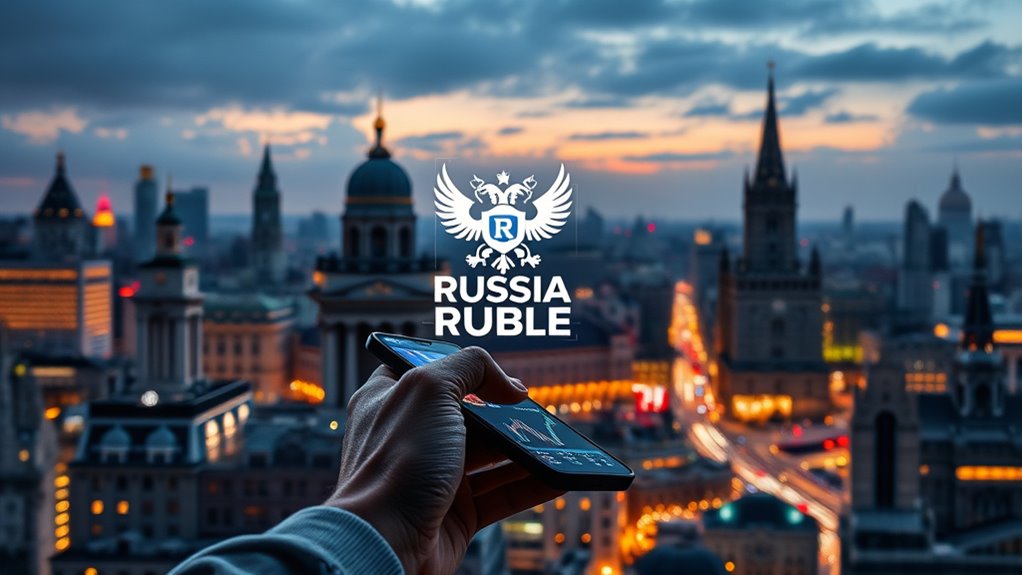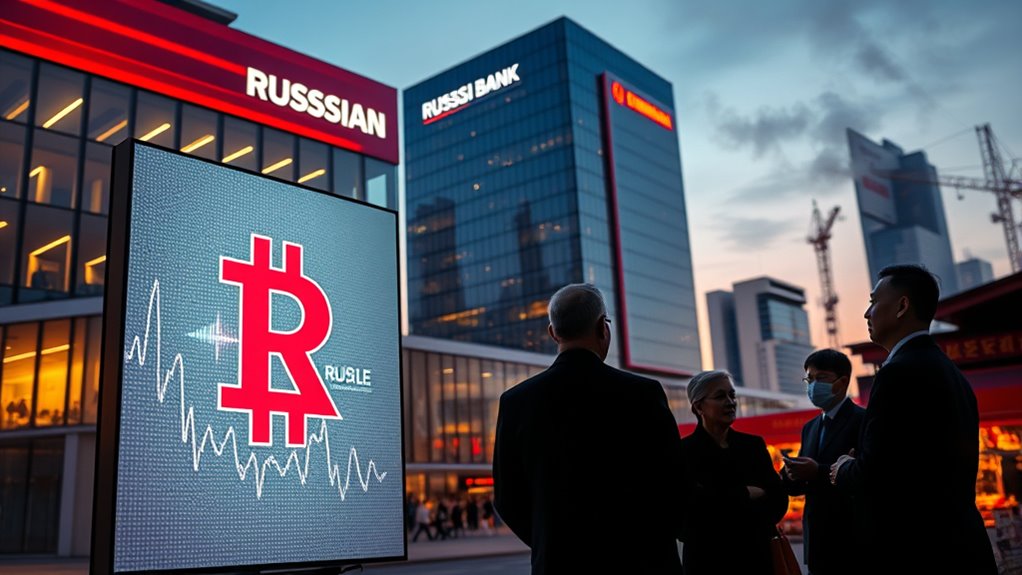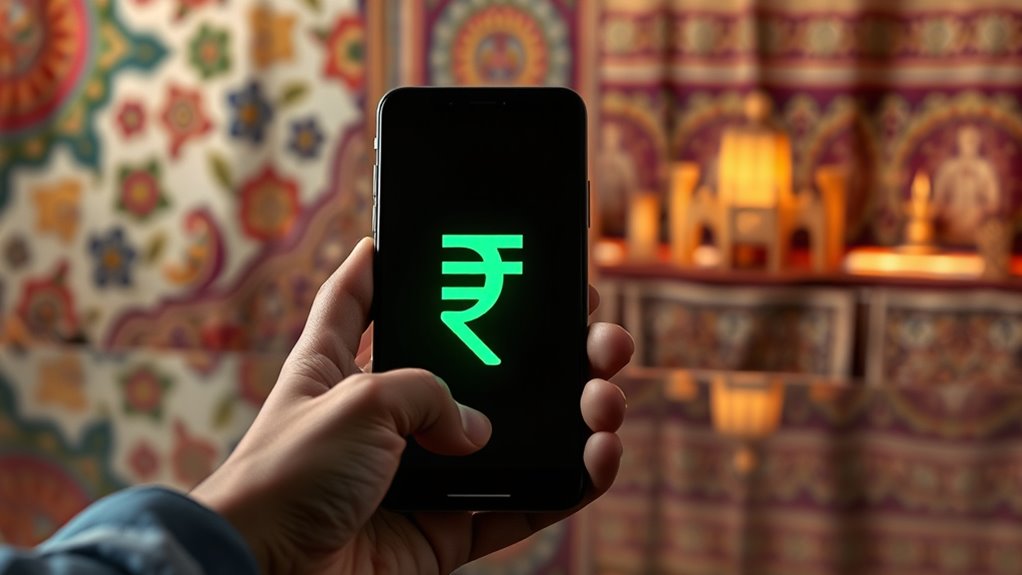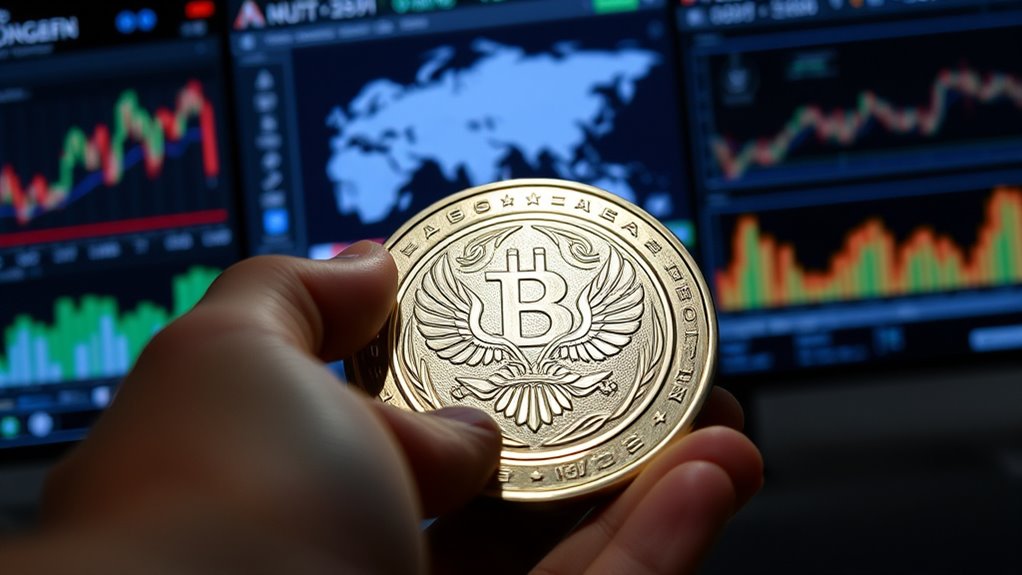The digital ruble could be your answer to understanding how Russia might dodge Western sanctions. Launched by the Central Bank of Russia, it promises faster, secure cross-border payments while reducing reliance on the US dollar. By partnering with countries like China and India, Russia enhances trade efficiency. This strategic move could reshape financial dynamics and bolster economic resilience. Curious about how this will impact global trade and financial systems? There's more to uncover about its implications.
Key Takeaways
- The digital ruble allows Russia to conduct international transactions without relying on traditional financial systems, reducing vulnerability to sanctions.
- By facilitating cross-border payments with countries like China, Turkey, and India, the digital ruble strengthens economic ties and trade alternatives.
- Enhanced transaction speed and lower costs associated with the digital ruble can improve business profitability while circumventing Western financial restrictions.
- The blockchain technology behind the digital ruble provides secure and transparent transaction methods, potentially increasing trust among international trading partners.
- As Russia promotes the digital ruble, it encourages de-dollarization, helping to diminish the influence of the US dollar in global trade.
Understanding the Current Landscape

As Russia faces increasing pressure from Western sanctions, it's clear the country is turning to innovative solutions to strengthen its financial resilience.
The digital ruble platform is a prime example of this shift, aiming to enhance the flexibility of Russia's financial system. Launched on August 15, 2023, this initiative by the Central Bank of Russia leverages cutting-edge financial technology, utilizing blockchain to facilitate faster, more secure cross-border payments. This method mirrors the trend of investing in alternative assets that provide greater control and potential for higher returns.
By providing an alternative to traditional banking methods that are limited by sanctions, the digital ruble seeks to help Russia de-dollarize its trade and transactions.
With plans for full availability by Q1 2025, this stable digital currency offers minimal risk compared to cryptocurrencies, ensuring greater stability during economic upheaval. Additionally, this development could lead to increased institutional participation in the digital finance space, reflecting a broader trend in global markets.
Pilot Programs Underway

As you explore the pilot programs underway for the digital ruble, you'll see that Russia kicked off testing with consumers on August 15, 2023. Thirteen Russian banks are participating, focusing on features like digital wallets and QR code payments. This initiative is essential for evaluating the digital currency's functionality before a full rollout expected by early 2025. Additionally, the implementation of the digital ruble may enhance customer interactions by providing more efficient payment solutions. Furthermore, this initiative reflects the growing trend of digital currencies in the global financial landscape.
Pilot Program Details
Since August 15, 2023, Russia has been testing its digital ruble with consumers, marking a significant step in its effort to enhance financial flexibility amidst international sanctions. This pilot program involves 13 Russian banks and a select group of customers, focusing on features like digital wallets, transfers, QR code purchases, and automated payments. AI-driven data analytics could support better decision-making in the implementation of the digital ruble and its features. With full availability projected for Q1 2025, the program aims to facilitate international transactions and reduce the impact of ongoing sanctions expected to last until at least 2026. Additionally, the digital ruble's implementation could allow for greater investment diversification in response to economic pressures.
Participating Banks Involved
While the Central Bank of Russia (CBR) leads the charge in launching the digital ruble, 13 prominent Russian banks are actively participating in the pilot programs to test its functionalities.
These participating banks, which include major financial institutions, work closely with the Russian central bank to facilitate seamless integration into the existing financial landscape. Additionally, this aligns with the growing importance of precious metals investment as a secure asset class during economic instability.
The pilot projects focus on features like digital wallets and QR code payments, aiming to assess the digital ruble's capacity for efficient transactions.
By the end of 2023, these programs are expected to expand to include companies, setting the stage for full availability by Q1 2025.
This initiative also reflects a broader trend towards enhancing cross-border transactions with countries like China and Turkey. Additionally, the digital ruble's implementation could potentially lead to a significant reduction in Tesla fire incidents, as it may streamline financial processes related to electric vehicle transactions.
What Russia's Digital Currency Means for Businesses

The introduction of Russia's digital ruble could greatly reshape how businesses operate, especially in the face of ongoing Western sanctions.
By facilitating international payments, the digital ruble offers several advantages for Russian companies:
- Reduced transaction costs: Streamlined processes can lower operational expenses.
- Enhanced cross-border capabilities: Businesses can transact more easily with international partners.
- Collaboration opportunities: Ties with countries like China and Turkey can improve payment networks. Additionally, understanding state-specific benefits can aid businesses in leveraging local advantages.
- Competitive landscape shift: Traditional Russian banks may struggle, prompting businesses to innovate.
As the digital ruble is expected to be fully implemented by Q1 2025, it will revolutionize how you manage financial transfers, purchases, and other transactions, ultimately enabling you to navigate sanctions more effectively. Additionally, the credit card debt in the U.S. highlights the importance of efficient payment processing as businesses adapt to new financial landscapes.
Digital Collaboration With East Asian and Global States

As Russia forges stronger ties with East Asian and global states, the adoption of the digital ruble is set to play a significant role in enhancing international collaboration. This initiative aims to facilitate international payments, particularly with countries like China, Turkey, and India. By integrating the digital ruble with other digital currencies, Russia enhances its cross-border payment capabilities, which is essential for evading sanctions. Additionally, this approach could leverage predictive modeling to improve decision-making in financial transactions. Moreover, the growing trend of digital currencies worldwide has prompted nations to rethink their monetary policies and international trade strategies.
| Country | Digital Currency | Collaboration Focus |
|---|---|---|
| China | Digital Yuan | Mutual settlements |
| Turkey | Digital Turkish Lira | Payment system gateways |
| India | Digital Rupee | Strengthening business ties |
These partnerships support Russia's broader de-dollarization efforts and diversify its financial systems.
The Role of China in Russia's Digital Currency Strategy

China plays an essential role in Russia's digital currency strategy by enhancing bilateral trade through mutual settlements using the digital ruble. As both countries explore cross-border payment systems, you're likely to see increased collaboration that reduces reliance on the US dollar. This partnership not only strengthens their economic ties but also supports their broader goal of financial independence, aligning with the trend of rising tensions among major powers that drives nations to seek alternative economic solutions. Additionally, the concept of shelf life of freshly squeezed juices demonstrates the importance of efficient resource management, which both nations may leverage in their economic strategies.
Bilateral Trade Enhancements
While maneuvering through the challenges posed by international sanctions, Russia is strategically leveraging the digital ruble to enhance its bilateral trade with China.
This collaboration not only strengthens economic ties but also aims to reduce reliance on the US dollar. Additionally, this partnership supports the development of hydrogen fuel cells, which are seen as a key player in the clean energy transition.
Key aspects of this partnership include:
- Facilitating mutual settlements using the digital ruble and digital yuan
- Establishing payment gateways for seamless cross-border transactions
- Expanding trade into sectors like energy and technology
- Promoting shared interests in de-dollarization and alternative financial systems
Additionally, this initiative mirrors the global trend towards renewable energy innovations, as countries seek to diversify their economic dependencies and foster sustainable growth.
Cross-Border Payment Systems
To navigate the complexities of cross-border transactions, Russia is increasingly relying on its digital ruble, with China's advanced digital Yuan playing an essential role in this strategy.
By leveraging China's robust payment systems, which boast over 260 million users, Russia can facilitate smoother mutual settlements. This collaboration not only enhances trade options but also enables Russia to diversify its financial systems amid ongoing sanctions. Furthermore, cultural intelligence is crucial in fostering effective partnerships that can adapt to diverse market needs.
Additionally, Russia's partnership with Turkey aims to establish a network of payment gateways that further supports the digital ruble's use in cross-border trade.
As Russia explores potential alliances with countries like India and its digital rupee, the synergy between Russia and China remains vital for developing effective digital currency strategies that can withstand external pressures. Furthermore, the incorporation of predictive analytics in transaction monitoring could enhance security measures against fraud and cyber threats in these cross-border payment systems.
Turkey's Position in Digital Currency Partnerships

As Turkey collaborates with Russia on digital currency initiatives, it positions itself as a key player in the evolving landscape of international finance. This partnership aims to create a network of payment gateways to facilitate mutual settlements, enhancing Turkey's financial ties with Russia amid sanctions.
- Turkey is piloting the digital Turkish Lira, aligning with the digital ruble initiative. This initiative could be influenced by gold IRA diversification strategies to mitigate economic risks.
- The collaboration offers an alternative to Western financial systems.
- It reflects Turkey's strategic interest in diversifying economic relationships.
- Both countries are exploring options to bypass the US dollar for trade.
- This move could potentially enhance asset diversification in their respective economies.
India's Engagement With the Digital Ruble

India's looking to strengthen trade partnerships with Russia through the digital ruble, creating an innovative cross-border payment system. By leveraging their respective digital currencies, both countries can enhance economic cooperation and streamline transactions. This engagement not only boosts trade but also helps India diversify its financial ties and reduce dependency on Western systems. Additionally, utilizing IRS-approved gold can provide a hedge against potential economic instability stemming from sanctions. Implementing such strategies may also foster awareness of filial responsibility laws, guiding financial planning for elder care in the event of economic repercussions.
Strengthening Trade Partnerships
While exploring new avenues for economic cooperation, India is actively engaging with Russia to adopt the digital ruble, aiming to bolster trade ties amid ongoing sanctions. This partnership is essential for enhancing bilateral trade and diversifying financial systems.
Consider these key factors in strengthening trade partnerships:
- The digital ruble offers a seamless international payment solution.
- India's digital rupee can facilitate mutual settlements with Russia.
- Both countries aim to reduce reliance on the US dollar in transactions.
- Developing a network of payment gateways will streamline cross-border transactions.
Through this strategic engagement, India and Russia aren't just dodging sanctions; they're pioneering a new era of digital financial cooperation that could reshape their economic landscape.
Cross-Border Payment Innovations
The exploration of the digital ruble opens up innovative avenues for cross-border payments between India and Russia. By adopting digital rubles, both countries can enhance their business ties while sidestepping reliance on the US dollar.
This collaboration aligns with India's own Central Bank Digital Currency (CBDC) initiative, creating efficient payment mechanisms for mutual settlements. As the digital ruble project progresses, it promises to streamline cross-border transactions, reduce costs, and bolster security, making it an attractive option for Indian businesses.
Furthermore, leveraging the digital ruble helps both nations navigate sanctions, ensuring economic relationships persist despite geopolitical tensions. Ultimately, this partnership could redefine international trade dynamics, offering a robust framework for future transactions.
Implications for European Financial Systems

As the digital ruble gains traction, its implications for European financial systems become increasingly significant. This new currency could reshape how Europe engages with Russia and other nations.
Here are some key considerations:
- The digital ruble may facilitate cross-border payments, reducing reliance on the US dollar and SWIFT.
- It could challenge the euro's dominance in trade, leading to shifts in power dynamics.
- European businesses might adopt the digital ruble to avoid sanctions and enhance transaction efficiency.
- The rise of this currency could prompt a reevaluation of regulatory frameworks and collaborations within the EU.
With blockchain technology at its core, the digital ruble poses both opportunities and challenges for European financial systems, demanding careful scrutiny.
The Impact of Western Sanctions on Russia's Economy

European financial systems are feeling the ripple effects of Western sanctions imposed on Russia, which have severely disrupted the country's economy. The sanctions have cut Russia off from the SWIFT payment system and restricted access to global financial markets. As a consequence, the ruble's value has plummeted by 45% since February 2022, leading to a push for the digital ruble. This currency aims to help businesses evade sanctions and maintain financial sovereignty.
| Impact of Sanctions | Effect on Russian Economy |
|---|---|
| Decline in Ruble Value | 45% drop since February 2022 |
| Access to Financial Markets | Severely restricted |
| Digital Ruble Initiative | Accelerated to mitigate effects |
The digital ruble is viewed as essential for international trade amidst ongoing pressures.
Future Prospects for the Digital Ruble in Global Trade

While many countries grapple with the implications of sanctions on global trade, the digital ruble emerges as a potential game-changer for Russia.
By leveraging blockchain technology, it promises to transform cross-border payments, making them faster and more secure.
Here's what you should know about its future prospects:
- Operational by Q1 2025: The digital ruble will facilitate seamless international trade.
- Reduced Transaction Costs: Businesses can save money while maneuvering through sanctions.
- Collaboration with Other Countries: Partnerships with China and Turkey may enhance mutual trade benefits.
- Circumventing Sanctions: The digital ruble could help Russia bypass restrictions imposed by Western financial systems.
With these features, the digital ruble stands to redefine how Russia engages in global commerce.
Frequently Asked Questions
What Is the New Russian Digital Currency?
The new Russian digital currency is the Digital Ruble, which aims to modernize financial transactions in Russia.
It allows you to make secure payments and transfers using digital platforms. Launched in pilot programs with select banks, it's set to become fully available by early 2025.
You'll find features like QR code payments and automated transactions, making it easier and more efficient for you to conduct business and manage your money digitally.
How Did Russia Stabilize the Ruble?
To stabilize the ruble, Russia focused on several key strategies.
You'll notice that they implemented measures to bolster the currency's value, like increasing interest rates and limiting capital outflows.
By enhancing trade relations with non-Western countries, they aimed to create a more stable economic environment.
Additionally, Russia sought to reduce reliance on the dollar and explore alternative payment systems, which helped restore some confidence in the ruble amid ongoing economic challenges.
Where Can I Buy a Digital Ruble?
You can't buy a digital ruble just yet, as it's still in the testing phase.
However, by 2025, you'll be able to acquire it through participating banks.
Keep an eye on the Central Bank of Russia for updates on registration and availability.
Once it's launched, you'll find it useful for various transactions.
As businesses adapt, new platforms will likely emerge to help you navigate this digital currency landscape.
Is Russia Allowed to Use Bitcoin?
Yes, Russia's allowed to use Bitcoin. The government's legalized cryptocurrencies for international trade, marking a significant shift in its financial approach.
You'll find Russia ranks second in Bitcoin mining, generating substantial revenue.
However, be aware that while you can engage in Bitcoin transactions, they come with risks, like public traceability on the blockchain. This could affect your desire for anonymity, so consider the implications before diving into cryptocurrency dealings.
Conclusion
So, here you are, watching Russia craft its digital ruble like a magician pulling a rabbit from a hat, all while the world tightens sanctions. Ironically, what seems like a desperate escape plan might just be the ticket to a new financial reality. As you ponder the paradox of innovation thriving under pressure, remember: in the game of sanctions and digital currencies, sometimes the best tricks come when you're backed into a corner.









